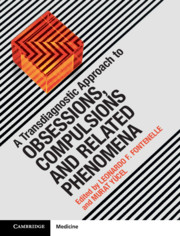Book contents
- A Transdiagnostic Approach to Obsessions, Compulsions and Related Phenomena
- Reviews
- A Transdiagnostic Approach to Obsessions, Compulsions and Related Phenomena
- Copyright page
- Dedication
- Contents
- Contributors
- Foreword
- Acknowledgments
- Section 1 Theoretical Foundations of Obsessive-Compulsive and Related Disorders
- Section 2 Practical Aspects of Obsessive-Compulsive Disorder
- Section 3 Practical Aspects of Other Obsessive-Compulsive Related Disorders
- 23 Transdiagnostic and Unique Clinical and Treatment Factors of Dysmorphophobia: Body Dysmorphic Disorder and Olfactory Reference Disorder
- 24 Hypochondriasis
- 25 Hoarding Disorder
- 26 Transdiagnostic Factors in Obsessive-Compulsive Personality Disorder
- 27 Tourette’s and Other Tic Disorders
- 28 Body-Focused Repetitive Behaviors
- 29 Stereotypic Movement Disorder
- 30 The Clinical Neuropsychiatry of “Organic” Obsessive-Compulsive Disorder
- 31 Behavioral Addictions
- 32 Other Obsessive-Compulsive Related Disorders
- Index
- References
29 - Stereotypic Movement Disorder
from Section 3 - Practical Aspects of Other Obsessive-Compulsive Related Disorders
Published online by Cambridge University Press: 14 December 2018
- A Transdiagnostic Approach to Obsessions, Compulsions and Related Phenomena
- Reviews
- A Transdiagnostic Approach to Obsessions, Compulsions and Related Phenomena
- Copyright page
- Dedication
- Contents
- Contributors
- Foreword
- Acknowledgments
- Section 1 Theoretical Foundations of Obsessive-Compulsive and Related Disorders
- Section 2 Practical Aspects of Obsessive-Compulsive Disorder
- Section 3 Practical Aspects of Other Obsessive-Compulsive Related Disorders
- 23 Transdiagnostic and Unique Clinical and Treatment Factors of Dysmorphophobia: Body Dysmorphic Disorder and Olfactory Reference Disorder
- 24 Hypochondriasis
- 25 Hoarding Disorder
- 26 Transdiagnostic Factors in Obsessive-Compulsive Personality Disorder
- 27 Tourette’s and Other Tic Disorders
- 28 Body-Focused Repetitive Behaviors
- 29 Stereotypic Movement Disorder
- 30 The Clinical Neuropsychiatry of “Organic” Obsessive-Compulsive Disorder
- 31 Behavioral Addictions
- 32 Other Obsessive-Compulsive Related Disorders
- Index
- References
- Type
- Chapter
- Information
- Publisher: Cambridge University PressPrint publication year: 2019



